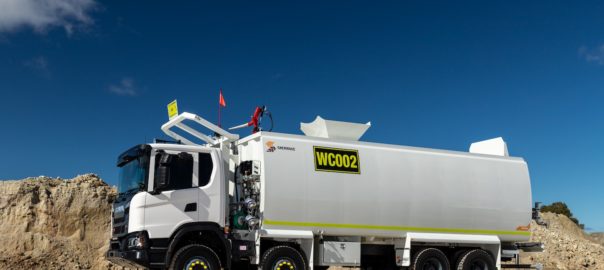Scania’s first new truck generation XT mining chassis have arrived in Australia and are already in use at a Pilbara mine site in Western Australia.
The two Scania NTG G 450 8×4 twin steer chassis have been fitted with new, higher-capacity 40,000-litre Shermac water cart bodies for the customer.
Scania says the tailor-made Shermac bodies are more than double the capacity of those fitted to traditional road-going trucks used on mine sites and are designed to replace mine-specific road train combinations.
“The new Scania XT trucks offer the customer a more cost-effective solution to the requirement for dust suppression and road building assistance on-site,” Scania says.
Robert Taylor, General Manager, Mining at Scania Australia, said the mining customer has had experience operating a fleet of Scania trucks on-site as service vehicles, flatbeds and technical support vehicles for the past year.
“The trucks were in service 24-hours per day, seven-days per week and have clocked up around 70,000 km on-site in their first 12 months. They have been very reliable in service and the drivers enjoyed the comfortable and quiet Scania cab,” he said.
“When we were discussing the replacement of the customer’s existing water carts, we suggested a more flexible solution, in the form of the NTG 450 XT 8×4 as they could handle the higher payload of 40,000-litres for a GVM (gross vehicle mass) of around 66 t,” Taylor said.
The water carts are also on call 24/7 and reliability is very important to the customer, Taylor added.
“They work in an extremely harsh environment where there is a lot of dust and heat and so water cart availability is critical to the mine’s operations. The vehicles will be serviced on-site to maximise uptime,” he said.
This new high-capacity water cart underscores Scania’s ability to configure a vehicle exactly to a client’s needs, according to Taylor.
“Our client wanted a reliable, high-capacity vehicle that could be maintained easily and quickly and one that could do the job day-in, day-out. The new Scania XT range is designed for these conditions and, in addition to being able to source and fit a suitable body, we have been able to deliver a solution at a reduced capital cost to the client compared with their previous solution,” he said.
“One of our longer-term goals has been to be able to offer our customers the ability to replace their very high-cost capital equipment with Scania solutions that provide a greater degree of resource utilisation flexibility as well as cut their capital expenditure without compromising availability or productivity. And we are able to deliver solutions in a timelier manner as well.
“With these new XT water carts we believe we are taking another significant step towards delivering on that strategy,” he said.
Jim Ray, who controls sales and sales management at mining engineering equipment supplier Shermac, said Scania was confident the 8×4 chassis would be suitable for this 40,000 litre payload, having seen 66 t payloads used widely in tipper configurations in South America and Indonesia mine sites.
“All of our water carts are custom designed and extensively tested to ensure optimum weight distribution and performance no matter how tough the environment or challenge,” Ray said.
“With liquid loads you do get high dynamic forces, but our Roadserve 2000 model water cart is well baffled and on-site speeds will be low and there are few inclines, allowing the vehicles to do their jobs reliably. Scania also has a lower centre of gravity compared with the previous solution, which also aids stability and safety,” he said.
The Scania NTG XT range has been designed for challenging operating conditions and comes with a 150 mm protruding steel front bumper bar that protects the vehicle against significant frontal knocks.
With protective grilles for the LED headlights, a fold-down bumper-mounted step to allow safe access for windscreen cleaning on-site, and a 40 t capacity tow point, the XT is suited to the operating conditions of a mine site. Additionally, Scania has added extra tough door mirror covers for the XT, as they are often very vulnerable to accidental damage.
Within the NTG cabs, all drivers are seated more comfortably in new seats, positioned closer to the screen and door for enhanced visibility, while repositioned A-pillars and mirrors provide an even safer and enhanced view out to the front and side.
The G 450 B8x4HZ chassis selected by the customer has a 5,950 mm axle distance, and two 12 t front axles and two 21 t rear drive axles for a GVM of 66 t.
The 450 hp (336 kW), 13 litre, six-cylinder in-line engine drives through a Scania Opticruise automated gear-change and GRSO935R transmission, with specific off-road mode built into the management system.
The latest and highest output Scania hydraulic retarder system is fitted to provide safe braking, preserving the service brake linings on the drum brakes, which are backed by ABS.
Steel leaf spring suspension all-round provides a solution for the on-site driving environment, backed up by a heavy-duty mechanical suspension for the cab to chassis connections. A new electrically powered cab tilting mechanism is occupational health and safety friendly, as well, Scania says.
Within the low roof day cab, the Scania XT is fitted with a steering-wheel mounted airbag as well as driver and passenger side curtain airbags designed to protect occupants in the event of a rollover.






